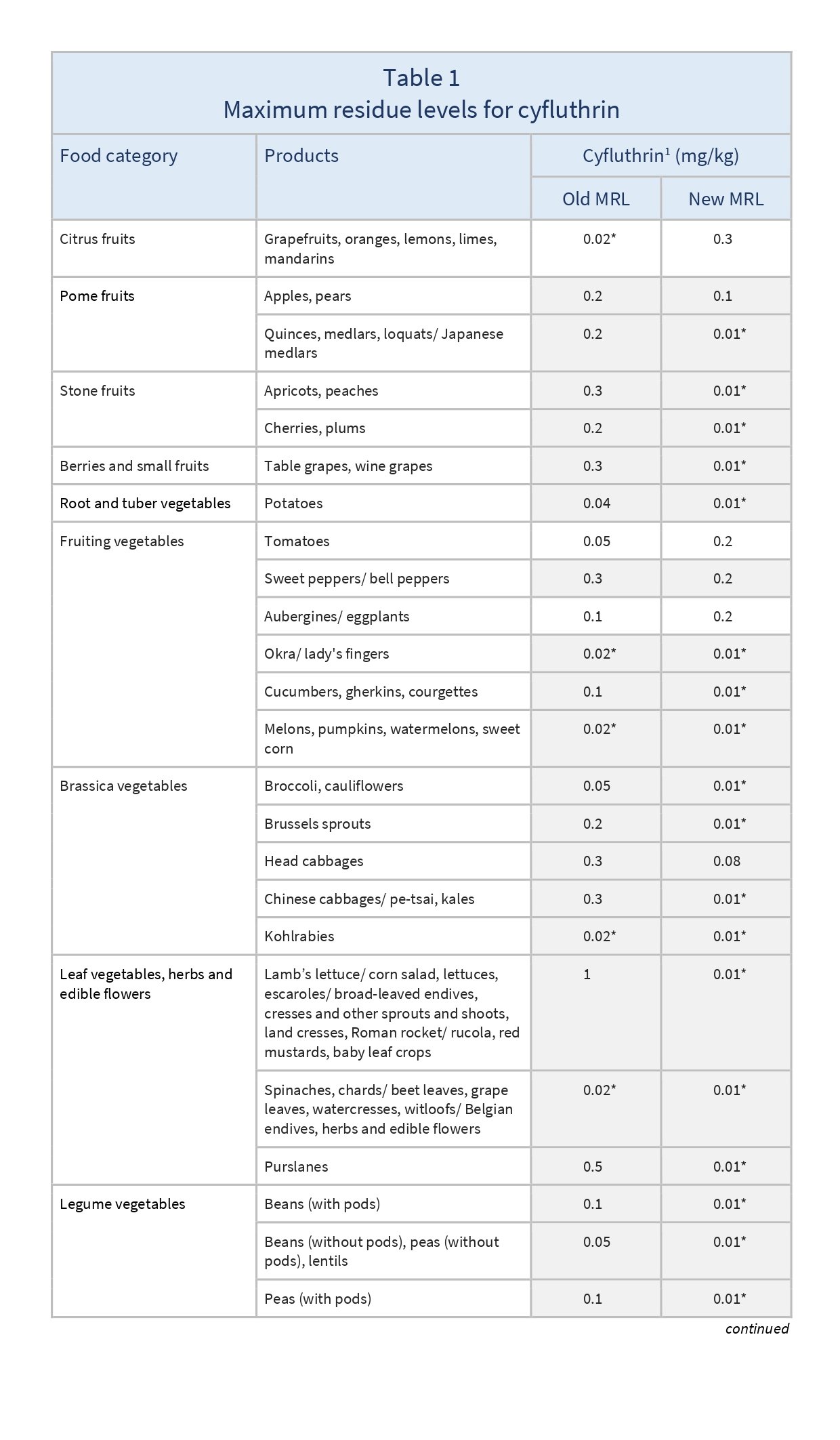Maximum residue levels for cyfluthrin
- Pesticide MRLs
Summary
The EU has lowered MRLs for cyfluthrin to the lowest limit of analytical detection (LOD: 0.01 – 0.05 mg/kg), on certain fruits (apricots, cherries, grapes, medlars, melons, peaches, plums, quinces, rhubarb, watermelons), vegetables (artichokes, asparagus, bamboo shoots, beans, broccoli, Brussels sprouts, cardoons, cauliflowers, celery, Chinese cabbages, courgettes, cucumbers, Florence fennels gherkins, kales, kohlrabi, leeks, lentils, lettuces, okra/lady’s fingers, palm hearts, peas, potatoes, pumpkins, purslanes , sweetcorn) cereals (hops, oats, rye) and sugar plants.
EU amends MRLs for cyfluthrin with an impact on certain fruits, vegetables and cereals
Commission Regulation (EU) 2023/173 of 26 January 2023 amending Annexes II and III to Regulation (EC) No 396/2005 of the European Parliament and of the Council as regards maximum residue levels for 1-methyl-3-(trifluoromethyl)-1H-pyrazole-4-carboxamide (PAM), cycloxydim, cyflumetofen, cyfluthrin, metobromuron and penthiopyrad in or on certain products
Update
The EU has lowered MRLs for cyfluthrin to the lowest limit of analytical detection (LOD: 0.01 – 0.05 mg/kg), on certain fruits (apricots, cherries, grapes, medlars, melons, peaches, plums, quinces, rhubarb, watermelons), vegetables (artichokes, asparagus, bamboo shoots, beans, broccoli, Brussels sprouts, cardoons, cauliflowers, celery, Chinese cabbages, courgettes, cucumbers, Florence fennels gherkins, kales, kohlrabi, leeks, lentils, lettuces, okra/lady’s fingers, palm hearts, peas, potatoes, pumpkins, purslanes , sweetcorn) cereals (hops, oats, rye) and sugar plants.
Impacted Products
grapefruits, oranges, lemons, limes, mandarins, apples, pears, quinces, medlars, loquats, Japanese medlars, apricots, peaches, cherries, plums, table grapes, wine grapes, potatoes, tomatoes, sweet peppers, bell peppers, aubergines, eggplants, okra, lady's fingers, cucumbers, gherkins, courgettes, melons, pumpkins, watermelons, sweet corn, broccoli, cauliflowers, Brussels sprouts, head cabbages, Chinese cabbages, pe-tsai, kales, kohlrabies, lamb’s lettuce, corn salad, lettuces, escaroles, broad-leaved endives, cresses, Roman rocket, rucola, red mustards, baby leaf crops, spinaches, chards, beet leaves, grape leaves, watercresses, witloofs, Belgian endives, herbs, edible flowers, purslanes, beans (with pods), beans (without pods), peas (without pods), lentils, peas (with pods), asparagus, cardoons, celeries, Florence fennels, leeks, rhubarbs, bamboo shoots, palm hearts, globe artichokes, linseeds, peanuts, groundnuts, poppy seeds, sesame seeds, sunflower seeds, mustard seeds, pumpkin seeds, safflower seeds, borage seeds, gold of pleasure seeds, hemp seeds, castor beans, rapeseeds, canola seeds, cotton seeds, buckwheat, common millet, proso millet, rice, sorghum, maize, corn, oat, rye, hops, seed spices, bark spices, bud spices, fruit spices, allspice, pimento, Sichuan pepper, caraway, cardamom, juniper berry, peppercorn, vanilla, tamarind, liquorice, turmeric, curcuma, sugar beet roots, sugar canes, chicory roots, animal products, muscle, liver, kidney, edible offals, milk
What is changing?
The EU has amended cyfluthrin MRLs as set out in Table 1.
In addition, the MRLs on tree nuts, berries (except grapes), miscellaneous fruits, root vegetables (except potatoes), bulb vegetables, fungi, algae, pulses and oil fruits have been lowered from 0.02 to 0.01 mg/kg (limit of determination (LOD), the lowest level analytically possible).
The LODs on teas, coffee, herbal infusions, cocoa and carob have been lowered from 0.1 to 0.05 mg/kg.
Why?
EFSA (2021) reviewed the MRLs for cyfluthrin. Although it is no longer approved as an active substance used in plant protection products in the EU, EFSA assessed the MRLs based on Codex Maximum Residue Limits (CXLs) and import tolerances.
EFSA recommended lowering MRLs for some commodities, raising MRLs for others, and maintaining current MRLs for commodities where sufficient data are available on good agricultural practices.
EFSA also identified a possible acute risk for consumers related to the CXL for cauliflower. The MRL was therefore lowered to the default value of 0.01 mg/kg.
The Authority concluded that some information was not available concerning the MRLs for barley and wheat. While these MRLs are considered safe, they will be reviewed within 2 years from the publication of this Regulation.
Timeline
The new MRLs apply from 16 August 2023.
Recommended Actions
Suppliers of certain fruits (apricots, cherries, grapes, medlars, melons, peaches, plums, quinces, rhubarb, watermelons), vegetables (artichokes, asparagus, bamboo shoots, beans, broccoli, Brussels sprouts, cardoons, cauliflowers, celery, Chinese cabbages, courgettes, cucumbers, Florence fennels gherkins, kales, kohlrabi, leeks, lentils, lettuces, okra/lady’s fingers, palm hearts, peas, potatoes, pumpkins, purslanes , sweetcorn) cereals (hops, oats, rye) and sugar beet roots should seek alternative solutions to the use of cyfluthrin.
Background
MRLs are set in accordance with the rules set out in Regulation 396/2005. For information on current MRLs for other substances, please consult the EU Pesticide Residues database.
Resources
EFSA (2021) Review of the existing maximum residue levels for Beta-cyfluthrin and Cyfluthrin according to Article 12 of Regulation (EC) No 396/2005. EFSA Journal, 19(9): 6837.
Sources
Commission Regulation (EU) 2023/173
Tables & Figures

.

Source: based on Commission Regulation (EU) 2023/173
Disclaimer: Under no circumstances shall COLEAD be liable for any loss, damage, liability or expense incurred or suffered that is claimed to have resulted from the use of information available on this website or any link to external sites. The use of the website is at the user’s sole risk and responsibility. This information platform was created and maintained with the financial support of the European Union. Its contents do not, however, reflect the views of the European Union.
